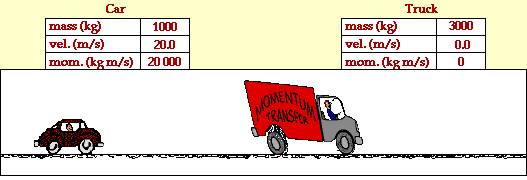
Car Rear Ends
Truck
Elastic
Collision
A GIF Animation
Collisions between objects are governed by laws of momentum and
energy. When a collision occurs in an isolated system, the total
momentum of the system of objects is conserved. Provided that there
are no net external forces acting upon the objects, the momentum of
all objects before the collision equals the momentum of all objects
after the collision. If there are only two objects involved in the
collision, then the momentum lost by one object equals the momentum
gained by the other object.
Certain collisions are referred to as elastic collisions. Elastic
collisions are collisions in which both momentum and kinetic energy
are conserved. The total system kinetic energy before the collision
equals the total system kinetic energy after the collision. If total
kinetic energy is not conserved, then the collision is referred to as
an inelastic collision.
The animation below portrays the elastic
collision between a 1000-kg car and a 3000-kg truck. The
before- and after-collision velocities and momentum are shown in the
data tables.

In the collision between the truck and the car, total system
momentum is conserved. Before the collision, the momentum of the car
is 20 000 kg*m/s and the momentum of the truck is 0 kg*m/s; the total
system momentum is 20 000 kg*m/s. After the collision, the momentum
of the car is -10 000 kg*m/s and the momentum of the truck is +30 000
kg*m/s; the total system momentum is 20 000 kg*m/s. The total system
momentum is conserved. The momentum lost by the car (30 000 kg*m/s)
is gained by the truck.
An analysis of the kinetic energy of the two objects reveals that
the total system kinetic energy before the collision is 200 000
Joules (200 000 J for the car plus 0 J for the truck). After the
collision, the total system kinetic energy is 200 000 Joules (50 000
J for the car and 150 000 J for the truck). The total kinetic energy
before the collision is equal to the total kinetic energy after the
collision. A collision such as this in which total system kinetic
energy is conserved is known as an elastic collision.
For more information on physical descriptions of motion,
visit
The
Physics Classroom. Specific information is available there on the
following topics:
This page was created by
Tom
Henderson of
Glenbrook South
High School.
Comments and suggestions can be sent by e-mail to
Tom
Henderson.
A hearty thanks is due to lab assistant Bryce Mautner for her
assistance with the graphics and GIF animation.
This page last updated on 3/26/97.
